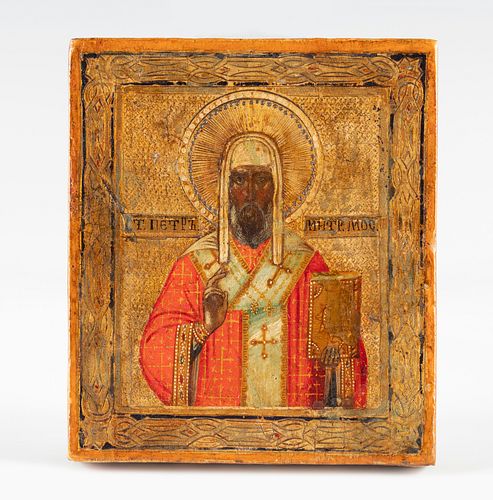Russian School, XIX century. "San Pietro Metropolitan of Moscow". Tempera and gold leaf on board.
Lot 110
About Seller
Setdart Auction House
Carrer Aragó 346
Barcelona
Spain
Setdart Subastas was born in 2004 and is currently the first online art auction in Spain with solidity, prestige and reliability guaranteed by our more than 60,000 users. Setdart has a young, dynamic and enterprising team ready to successfully manage the purchase and sale of art works through custom...Read more
Estimate:
EUR€1,500 - EUR€1,800
$1,612.90 - $1,935.48
Absentee vs Live bid
Two ways to bid:
- Leave a max absentee bid and the platform will bid on your behalf up to your maximum bid during the live auction.
- Bid live during the auction and your bids will be submitted real-time to the auctioneer.
Bid Increments
| Price | Bid Increment |
|---|---|
| EUR€0 | EUR€10 |
| EUR€200 | EUR€25 |
| EUR€500 | EUR€50 |
| EUR€1,000 | EUR€100 |
| EUR€3,000 | EUR€200 |
| EUR€5,000 | EUR€500 |
| EUR€10,000 | EUR€1,000 |
| EUR€20,000 | EUR€2,000 |
| EUR€50,000 | EUR€5,000 |
About Auction
By Setdart Auction House
Nov 3, 2021
Set Reminder
2021-11-03 08:00:00
2021-11-03 08:00:00
America/New_York
Bidsquare
Bidsquare : OLD MASTERS
https://www.bidsquare.com/auctions/setdart-auction-house/old-masters-7786
Setdart Auction House sofia@setdart.com
Setdart Auction House sofia@setdart.com
- Lot Description
Russian School, XIX century. "San Pietro Metropolitan of Moscow". Tempera and gold leaf on board. Measurements: 8,5 x 7,5 cm. This small icon, with the carved frame, represents the San Pietro Metropolitano of Moscow, as the inscription indicates. It is a canonical iconography, front and half-body, holding the closed gospel, in the left hand, and with the right hand raised in symbol of the blessing with two fingers, which can indicate that it can belong to the workshops of the old Muscovite believers. St. Peter, Metropolitan of Moscow and All Russia, was born in Volyn. Before the baby was born, his mother had a wonderful dream in which she saw a lamb with a cross. At the age of 12, Pietro took the veil. After a while he founded the Ratsk monastery, of which he later became abbot. In the course of his various monastic duties, Pietro devoted much time to iconography. In 1308, at the request of the prince of Galicia-Volynsk, he left for Constantinople as a candidate for metropolitan. His rival Gerontius saw in a dream the Mother of God who foretold Peter's victory. This was so, but the unrest in Kiev caused St. Pietro to move to Vladimir. From Vladimir, Pietro went to Moscow, imagining, in what was then a small town, the future capital of a great state. St. Pietro also brought to Moscow an image of the Mother of God painted by him, which became the first miraculous icon of Moscow, called Petrovskaya, lost today. St. Pietro laid the foundation for the Cathedral of the Assumption inside the Moscow Kremlin, bequeathing himself to be buried there. He died before the construction of the cathedral was completed, and when it was consecrated his relics had already rested there. Moscow chronicles recorded numerous healings on the relics of St. Pietro. In 1339 he was canonized in Constantinople.
- Shipping Info
-
In-house shipping available. Please inquire at admin@setdart.com.
-
- Buyer's Premium



 EUR
EUR CAD
CAD AUD
AUD GBP
GBP MXN
MXN HKD
HKD CNY
CNY MYR
MYR SEK
SEK SGD
SGD CHF
CHF THB
THB
















